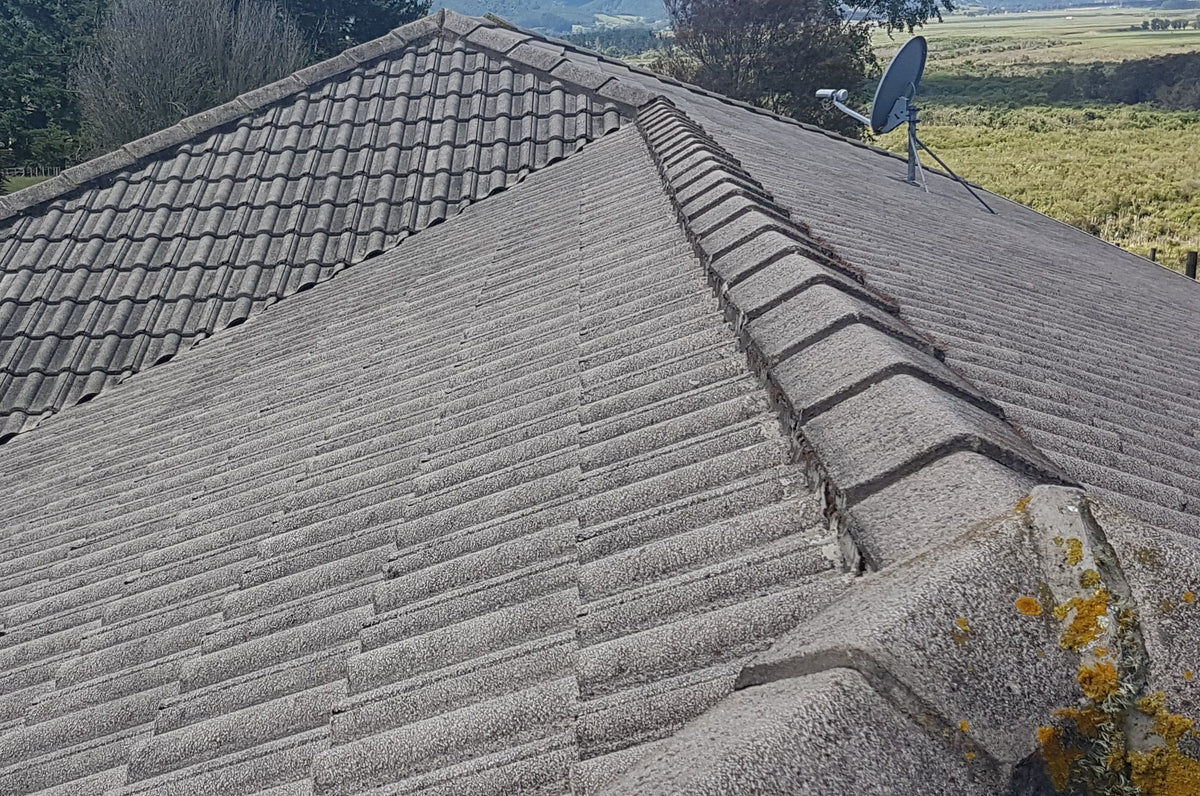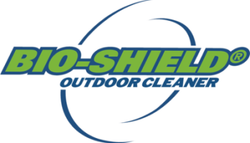Cleaning Concrete Tile Roofs
How To Clean Concrete Tile Roofs with Bio-Shield®
Including cleaning of:
- Obsolete Concrete Tiles, including Atlas, Koncrete, Peter Pan, ST, Quality, LGS
- Modern Concrete Tiles, including Monier, Boral, Humes BGC
Should I pressure clean or use Bio-Shield to clean a concrete tile roof?
The dark discoloration on concrete tile roofs is commonly mistaken for dirt, leading homeowners to believe that the roof needs to be pressure cleaned. The dark colour is actually black algae, not dirt.
Pressure cleaning of concrete tile roofs can damage the surface and mortar joints, prematurely eroding the factory-applied cement-based color coating, and tile roofs will always leak when pressure cleaned.
Pressure cleaning is a time consuming, expensive, and ultimately futile way to clean these surfaces: if they are not sterilized in conjunction with pressure cleaning, the spores within the tiles will quickly regrow and discolor the roof again. Older concrete roofs can also begin to leak from small pinholes or porous areas in the tiles that are opened up by the high-pressure water jet.
The best method for cleaning and maintaining concrete tile roofs are exterior cleaning solutions like Bio-Shield®.
A simple application will kill and remove the moss, algae and lichen growths and keep the surface clean for extended periods.
No pressure cleaning or scrubbing is required to get a clean roof.
Once the roof is clean, regular lighter applications of Bio-Shield at the first sign of re-growths will effect a rapid clean up and keep the surface clean again for an extended period.
A tile roof maintained in a clean condition with Bio-Shield will also prevent the build up of sludge in the spoutings, reducing rusting and blockages that cause spoutings to overflow in heavy rain.
Why choose Bio-Shield® for your D.I.Y Concrete Tile roof cleaning?
Bio-Shield® has been developed to clean any exterior surface through 39 years of use in a demanding commercial environment so it works extremely well.
Bio-Shield® is a high quality product, and contains no bleach, salts, acids or phosphates
The high concentration of active ingredients in Bio-Shield® when compared to other outdoor cleaners means it will cost less per diluted litre and cover more area at a lower cost.



Bio-Shield® Application Instructions
Safety
Most falls from roofs are by homeowners working on their own roofs on the weekend.
If you have any doubts about your ability to to carry out this work safely then do not attempt it.
We have an application service here at www.roofcleaning.co.nz that will quote on treating your roof.
From around $290 the work can be done with no risk to yourself.
If you still want to do it by yourself then please be careful and use a safety rope secured to something solid to prevent a fall.
Walking on Concrete Tile Roofs
To prevent damage to the tiles the best place to walk is in the centre of the tile at the bottom edge. This is the strongest part of the tile due to the design and it is supported by both the tile and tile batten underneath.
Avoid the overlapping outside edge of the tile, this is the weakest part and breaks easily.
Preparation
For a successful DIY job, preparation is the key. Following these simple steps will ensure a professional looking finish and long lasting protection against fungal and moss regrowth damaging your roof.
Place your ladder on firm ground at the point where the distance between roof and ground is smallest. For every four metres in height the ladder base should be placed 1 metre out from the spouting. The top of the ladder should extend at least 1 metre above the edge of the roof to make entering and exiting the roof as safe as possible.
Placing the ladder against the spouting brackets will reduce the possibility of breaking PVC spouting or deforming metal spoutings.
The first trip up the ladder should be made to tie it to the spouting, ideally with a bungee cord or luggage tie to prevent the ladder from slipping. Colourbond or painted spoutings should have some protection placed between the spouting and ladder to stop scratching of the coating.
Remove loose debris, tree leaves, dirt etc, from the roof surface. Cutting back overhanging trees will help the roof to clean up and help keep it clean.
The concrete roof surface can be either dry or damp.
Check local governing body regulations for discharge of wash water into the storm water system.
If you are on tank water disconnect the tank from the roof. It will need to stay disconnected for 2 to 4 weeks, and until the roof is flushed by enough rain to remove all traces of the Bio-Shield from the run of water.
Do not reconnect the tank until the water is free of frothing or odour.
Check the weather forecast, or rain radar - brief showers after application on a porous surface will assist the action of Bio-Shield®
Air temperature above 10 degrees C° will help to accelerate biocidal action.
Premix the Bio-Shield® 1 part to 20 parts water in a pressure sprayer.
If using the Jet-Stream Applicator, follow the instruction on the back label.
Bio-Shield® Mixing Ratios for Pressure Sprayers
| Clean Water | Bio-Shield Concentrate | Diluted Bio-Shield |
|---|---|---|
| 1 Litre | 50 ml | 1.05 Litres |
| 10 Litres | 500 ml | 10.5 Litres |
| 15 Litres | 750 ml | 15.75 Litres |
| 20 Litres | 1 Litre | 21 Litres |
Application
If you have a respirator, now is the time to put it on, along with a pair of gloves and soft soled shoes and/or a pair of long pants. If you don't have a respirator, try to stay upwind during application. Evaporation of the solution on a warmer day will generate vapour that should be avoided where possible.
Application is best done on an overcast day at any time of the year, or early morning and late afternoon in summer if a warm sunny day is forecast. This slows evaporation and speeds the treatment process.
Saturation is the Key to Success - ensure saturation so the tiles stay wet for 10 to 15 minutes
Fill your sprayer with the premixed Bio-Shield® solution and pump it up to pressure.
Dividing the area to be treated into sections makes application easier.
Use the rows of tiles to help guide you - say a spray path of 2 to 3 rows of tiles.
Start at the highest point i.e.at the ridge tiles,
Begin application to the surface in slow, even strokes. Allow the following stroke to overlap the previous stroke by 50% to ensure even and complete coverage. Once the row of 3 tiles is complete move to the next 3 rows.
Any moss growth growing in the tile laps will need to be saturated with Bio-Shield® to ensure penetration to the roots and achieve a good kill.
Inject the Bio-Shield into any large moss clumps to ensure saturation.
Some tiles in damp areas will also have moss growths on the bottom edge of the tile, so ensure this is also saturated Aim for the surface to stay wet for 5 to 10 minutes after application.
Chimneys, solar panels, vent pipes, spoutings and skylights can all be treated with Bio-Shield while you are on the roof.
On lighter coloured roofs there will be a noticable disclouration as the Bio-Shield works to break down the black algae.
This discolouration is normal and willl fade over 24 to 48 hours.
Clean Up
Over the next few days any lichens and moss will begin to change color as they die off.
For the initial clean up, it may take 3 to 9 months on modern concrete tiles and to fully clean up as rain progressively washes the dead growths away.
The cleanup progress can accelerate in the 9 to 12 month period as the dead growths are softer and easily washed away.
Maintenance
Once your roof is clean, Bio-Shield will give optimal protection with regular treatments.
Best practice is to reapply Bio-Shield at the first signs of re-growth. Typically this will be every 2 to 3 years.
Two for three yearly applications will be easier, faster and use less diluted solution; any new growths will die off and the roof will clean up quickly.
Any areas of the roof where birds habitually sit and areas under trees, TV aerials or pipes that discharge water onto the roof, will show re-growth's first and can be spot treated as required.
